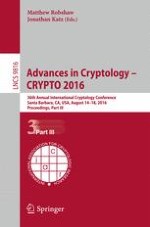The three volume-set, LNCS 9814, LNCS 9815, and LNCS 9816, constitutes the refereed proceedings of the 36th Annual International Cryptology Conference, CRYPTO 2016, held in Santa Barbara, CA, USA, in August 2016.
The 70 revised full papers presented were carefully reviewed and selected from 274 submissions. The papers are organized in the following topical sections: provable security for symmetric cryptography; asymmetric cryptography and cryptanalysis; cryptography in theory and practice; compromised systems; symmetric cryptanalysis; algorithmic number theory; symmetric primitives; asymmetric cryptography; symmetric cryptography; cryptanalytic tools; hardware-oriented cryptography; secure computation and protocols; obfuscation; quantum techniques; spooky encryption; IBE, ABE, and functional encryption; automated tools and synthesis; zero knowledge; theory.

